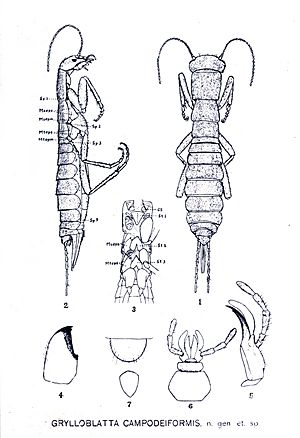Northern rock crawler facts for kids
Quick facts for kids Grylloblatta campodeiformis |
|
|---|---|
 |
|
| Scientific classification | |
| Kingdom: | |
| Phylum: | |
| Class: | |
| Order: | |
| Family: | |
| Genus: |
Grylloblatta
|
| Species: |
G. campodeiformis
|
| Binomial name | |
| Grylloblatta campodeiformis Walker, 1914
|
|
The Grylloblatta campodeiformis, also known as the Northern Rock Crawler, is a unique insect found in North America. It's an omnivore, meaning it eats both plants and other small creatures. This fascinating insect belongs to a special group called Grylloblattidae, and it's only found in certain parts of North America.
Contents
How Scientists Classify Northern Rock Crawlers
Scientists like to group living things to understand them better. This is called taxonomy. The Northern Rock Crawler was first discovered and described by a scientist named Edmund Murton Walker in 1914. When it was first found, scientists thought it belonged to the order Orthoptera (which includes grasshoppers and crickets). However, after more study, it was moved to a different order called Notoptera.
There are currently four different types, or subspecies, of the Northern Rock Crawler:
- G. c. athapaska Kamp, 1979
- G. c. campodeiformis Walker, 1914
- G. c. nahanni Kamp, 1979
- G. c. occidentalis Silvestri, 1931
What Do Northern Rock Crawlers Look Like?
Adult Northern Rock Crawlers are usually about 3 cm (1.2 in) long. This measurement does not include their ovipositors (a tube for laying eggs) or their cerci (tail-like feelers). They are long and do not have wings.
These insects are a uniform honey-yellow color and are covered with very short hairs. Unlike some other insects in their family, G. campodeiformis has eyes with about 70 small parts called facets. Their head is quite flat and rounded. The thorax, which is the middle part of their body, is long and makes up over a third of their total body length. The abdomen, or the back part, has 10 segments and is more than half of their body length.
Their legs are long and thin, perfect for running. They have strong coxae (the first part of the leg) and long femora (the thigh part). Their antennae are long, about 9 mm (0.35 in), and look like thin threads. Adult rock crawlers can have between 24 and 27 small sections on their antennae.
What Do Northern Rock Crawlers Eat?
Northern Rock Crawlers are active at night. They are nocturnal predators and scavengers. This means they hunt for small, spineless creatures like other insects. They also search for "insect-fallout" on snowfields. This is when wind carries dead insects onto the snow, and the rock crawlers find them to eat.
Where Do Northern Rock Crawlers Live?
This species was first found on Sulphur Mountain in Alberta, Canada, high up in the Canadian Rockies. Since then, they have also been found in British Columbia (Canada), and in Montana and Washington in the United States.
They live on the ground, often hiding between small stones and debris during the day. While they can survive warmer temperatures up to 20.5 °C (68.9 °F), they prefer cooler weather. They become active on snow fields when temperatures are around 0 °C (32 °F). This makes them psychrophilic, which means they love cold environments.
Like other rock crawlers in North America, G. campodeiformis is at some risk of extinction. This is because they need very specific cold habitats, and they don't move around much, making it harder for them to find new homes if their current one is disturbed.


